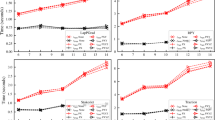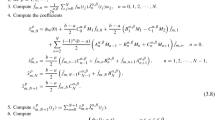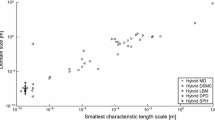Abstract
This paper introduces a novel framework with the ability to adjust simulation’s accuracy level dynamically for simplifying the dynamics computation of large particle systems to improve simulation speed. Our new approach follows the overall structure of the well-known Fast Multipole Method (FMM) coming from computational physics. The main difference is that another level of simplification has been introduced by combining the concept of motion levels of detail from computer graphics with the FMM. This enables us to have more control on the FMM execution time and thus to trade accuracy for efficiency whenever possible. At each simulation cycle, the motion levels of detail are updated and the appropriate ones are chosen adaptively to reduce computational costs. The proposed framework has been tested on the simulation of a large dynamical flocking system. The preliminary results show a significant complexity reduction without any remarkable loss in the visual appearance of the simulation, indicating the potential use of the proposed model in more realistic situations such as crowd simulation.







Similar content being viewed by others
References
Rokhlin V (1983) Rapid solution of integral equations of classical potential theory. J Comput Phys 60(2):187–207
Greengard L, Rokhlin V (1987) A fast algorithm for particle simulations. J Comput Phys 73(2):325–348
Greengard L, Rokhlin V (1988) Rapid evaluation of potential fields in three dimensions. In: Lecture notes in mathematics, vol 1360. Springer, Berlin, pp 121–141
Dongarra J, Sullivan F (2000) The top ten algorithms of the century. Comput Sci Eng 2(1):22–23
Razavi SN, Gaud N, Mozayani N, Koukam A (2011) Multi-agent based simulations using fast multipole method: application to large scale simulations of flocking dynamical systems. Artif Intell Rev 35(1):53–72
Razavi SN, Gaud N, Koukam A, Mozayani N (2011) Using motion levels of detail in the fast multipole method for simulation of large particle systems. In: WMSCI 2011, Orlando
Carlson DA, Hodgins JK (1997) Simulation levels of detail for real-time animation. In: Graphic interface, pp 1–8
Chenney S, Forsyth D (1997) View-dependent culling of dynamic systems in virtual environments. In: ACM symposium on interactive 3D graphics, New York
Grzeszczuk R, Terzopoulos D, Hinton G (1998) Neuroanimator: fast neural network emulation and control of physics-based models. In: SIGGRAPH, New York, pp 9–29
Popovic Z, Witkin A (1999) Physically based motion transformation. In: SIGGRAPH, New York, pp 11–20
Brudlerlin A, Calvert TW (1996) Knowledge-driven, interactive animation of human running. In: Graphics interface, pp 213–221
Granieri JP, Crabtree J, Badler NI (1995) Production and playback of human figure motion for 3d virtual environments. In: VRAIS, pp 127–135
Perlin K (1995) Real time responsive animation with personality. IEEE Trans Vis Comput Graph 1(1):5–15
Multon F, Valton B, Jouin B, Cozot R (1999) Motion levels of detail for real-time virtual worlds. In: ASTC-VR’99
Faloutsos P, van de Panne M, Terzopoulos D (2001) Composable controllers for physics-based character animation. In: SIGGRAPH 2001, New York, pp 251–260
O’Sullivan C, Dingliana J (2001) Collisions and perception. ACM Trans Graph 20(3)
O’Brien D, Fisher S, Lin MC (2001) Automatic simplification of particle system dynamics. In: Computer animation, Seoul, pp 210–257
Greengard LF (1987) The rapid evaluation of potential fields in Particle systems. Yale University, New Haven, PhD Thesis
Barnes JE, Hut P (1986) A hierarchical O(NlogN) force calculation algorithm. Nature 324(6096):446–449
Hanrahan P, Salzman D, Aupperle L (1991) A rapid hierarchical radiosity algorithm. In: SIGGRAPH, New York, pp 197–206
Elliott WD, Board JA (1996) Fast Fourier transform accelerated fast multipole algorithm. SIAM J Sci Comput 17(2):398–415
Karaboga D, Akay B (2009) A survey: algorithms simulating bee swarm intelligence. Artif Intell Rev 31(1):61–85
O’loan OJ, Evans MR (1999) Alternating steady state in one-dimensional flocking. J Phys, A Math Gen 32(8)
Reynolds CW (1987) Flocks, herds, and schools: a distributed behavioral model. Comput Graph 21:25–34
Shimoyama N, Sugawara K, Mizuguchi T, Hayakawa Y, Sano M (1996) Collective motion in a system of motile elements. Phys Rev Lett 76(20):3870–3873
Mogilner A, Edelstein-Keshet L (1999) A non-local model for a swarm. J Math Biol 38(6):534–570
Toner J, Tu Y (1998) Flocks, herds, and schools: a quantitative theory of flocking. Phys Rev E 58(4):4828–4858
Tanner HG, Jadbabaie A, Pappas GJ (2003) Stable flocking of mobile agents, part II: dynamic topology. In: 42nd IEEE conference on decision and control, Maui, Hawaii, pp 2016–2021
Zhou J, Yu W, Wu X, Small M, Lu JA (2009) Flocking of multi-agent dynamical systems based on pseudo-leader. arXiv:0905.1037v1 [nlin.CD]
Olfati-Saber R (2006) Flocking for multi-agent dynamic systems: algorithms and theory. IEEE Trans Autom Control 51(3):401–420
Liu H, Fang H, Mao Y, Cao H, Jia R (2010) Distributed flocking control and obstacle avoidance for multi-agent systems. In: Control conference, Beijing, pp 4536–4541
Mousavi MSR, Khaghani M, Vossoughi G (2010) Collision avoidance with obstacles in flocking for multi agent systems. In: Industrial electronics, control & robotics (IECR), Orissa, pp 1–5
Olfat-Saber R, Murray RM (2003) Flocking with obstacle avoidance: cooperation with limited communication in mobile networks. In: 42nd IEEE conference on in decision and control, Maui, Hawaii, pp 2022–2028
Olfati-Saber R, Murray RM (2003) Consensus protocols for networks of dynamic agents. In: American control conference, Denver, pp 951–956
Author information
Authors and Affiliations
Corresponding author
Appendix: Numerical results
Appendix: Numerical results
Rights and permissions
About this article
Cite this article
Razavi, S.N., Gaud, N., Koukam, A. et al. Automatic dynamics simplification in Fast Multipole Method: application to large flocking systems. J Supercomput 62, 1537–1559 (2012). https://doi.org/10.1007/s11227-012-0816-4
Published:
Issue Date:
DOI: https://doi.org/10.1007/s11227-012-0816-4




